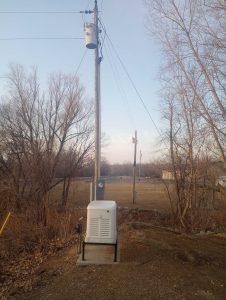If I had a dime for every time, over the last three plus decades, I have had a potential client even bring up using old telephone (utility) poles for constructing a new pole barn, I would be retired and sitting on the beach in Ecuador now!
Pole buildings are designed with the thought of being economical and efficient permanent structures. Given the cost of an average finished pole building, including site work, access improvements, materials, construction, concrete work and utilities being in the neighborhood of $50,000 – it appears those who are investing in them, see them as being permanent improvements as well.
 Utility companies have a huge financial investment in their infrastructure, which includes utility poles. The cost of a pole is far more than the piece of treated timber itself – it includes transportation (from the treatment plant, to the utility company yard, to the installation location), equipment and time to install the pole, as well as regular upkeep and maintenance. With all of these costs, and the pressure to not lose money, utility poles are not normally going to be replaced any earlier in their life cycle than has to be done.
Utility companies have a huge financial investment in their infrastructure, which includes utility poles. The cost of a pole is far more than the piece of treated timber itself – it includes transportation (from the treatment plant, to the utility company yard, to the installation location), equipment and time to install the pole, as well as regular upkeep and maintenance. With all of these costs, and the pressure to not lose money, utility poles are not normally going to be replaced any earlier in their life cycle than has to be done.
A survey of 150 utility companies found the average service life of utility poles to range from 25 to 37 years. The most common reason for replacement being, “strength degradation from ground line decay”. Other reasons for replacement included pole top decay, decay at connections, splitting of pole tops and excessive weathering.
The majority of utility poles are pressure treated with oil based pentachlorophenol (PCP). PCP does not bond with the cells of the wood – and is subject to the forces of gravity. Witness a brand new utility pole; it has a general appearance of being evenly treated for its entire length. Over time, the chemicals are pulled upon by gravity, slowly migrating towards the butt end of the pole (as well as potentially leaching into the ground). When the chemicals become thin enough at the ground line – the pole becomes subject to often rapid decay.
Considering the use of used utility poles for pole barn construction? Think twice, if they outlived their useful life as a power pole in 25 to 35 years, what would lead one to believe they would be effective as supports for a permanent (and often costly) pole building?
While I am at it, see my blog of yesterday….where I discuss the dangers of using PCP treated posts…for anything!






